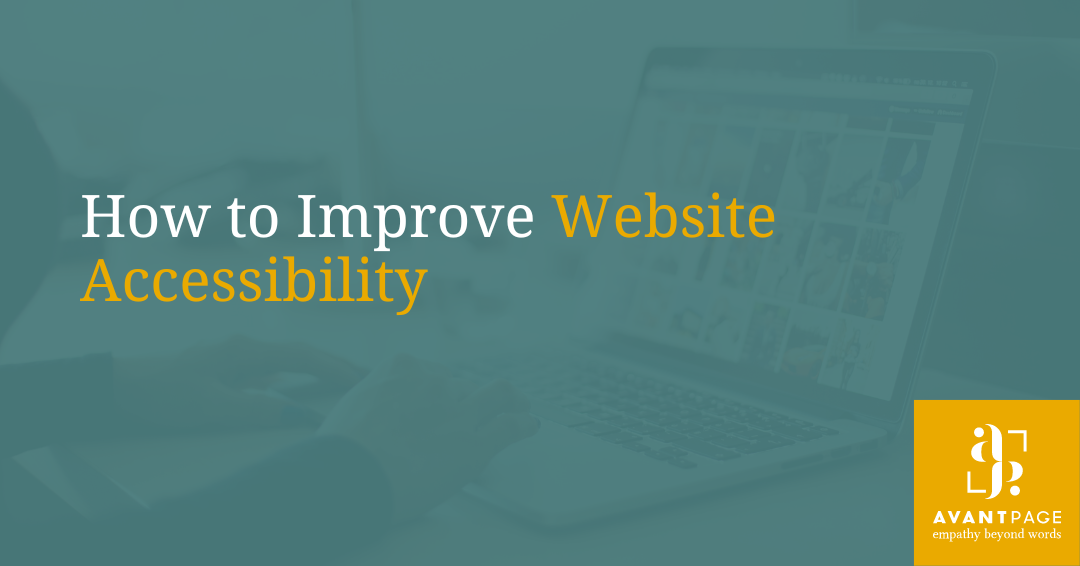Website accessibility is a way to promote access on your website for those with disabilities. Improving a website’s accessibility benefits everyone—a better structure and experience means greater satisfaction and connection to your brand. You can implement coding, design, and content items to make your website accessible. In 2008, the World Wide Web Consortium (W3C) created Web Content Accessibility Guidelines (WCAG) to share common standards for website accessibility. The guidelines are organized around these four principles: perceive, operate, understand, and interact with the web.
Numerous online tools (software programs or online services) are available to test out your website to see how it meets accessibility guidelines. W3C has an extensive list of online tools that you can filter to find one that meets your needs. Using one of these tools is a good starting point to get an idea of the current state of your website’s accessibility.
In this blog, we’ll look at ways that you can make your website accessible by making it more understandable through plain language, functional with webpage accessibility, and more accessible to everyone by professional translations. To learn more about ways to make your website more accessible via perception, operable or robust, read how a California health plan provider achieved linguistic and accessibility compliance.
1. Use Plain Language
Plain language is defined by the Plain Writing Act of 2010 as:
Writing that is clear, concise, well-organized, and follows other best practices appropriate to the subject or field and intended audience.
The government developed plain language as a guide to help save federal agencies time and money while better serving Americans. Plain language benefits both the audience (makes content easier to understand and navigate through) and the writers (shorter authoring time and enables people to take action more quickly). In addition, the concise, active tense style of writing for plain language can help facilitate an easier start for translations.
Here are some recommendations for writing in plain language:
- For readability, use a resource like this one. Add your content, and the site will grade it and show issues like if it is within the recommended Flesch-Kincaid Grade Level threshold.
- Keep content short: keep sentences under 21 words and paragraphs less than six sentences.
- Use active tense. Tools like grammarly.com and WordPress with the Yoast plugin will show you if a page’s content has passive voice.
- Simplify your word choice. Find common alternatives for words with this phrase and word list or PDF Plain language word list.
- Consider the content’s structure. Sometimes content can be better digested in bullets or tables, or broken up into levels of headings.
- Avoid compound words. Learn how to identify compound words here.
- Don’t use idiomatic expressions. Google your phrase or learn about What is an Idiom.
For more information, the plainlanguage.gov website provides many resources, including guidelines, training, and more.
2. Improve the Website Accessibility
The WCAG guidelines include many items related to the technical aspects of accessibility, such as making the site navigable by keyboards, elements readable by screen readers, and much more. In regards to language accessibility and understanding, you can make changes to the content and the content’s structure to help the user with website access.
Here are some recommendations for improving the user experience and structure:
- Provide a site map and breadcrumb trails, so a visitor knows where they are on a site.
- Clearly structure your page’s headers (H1, H2, H3, body text, etc.). Text with headings is easier to digest and enables a visitor to jump to relevant information.
- As we mentioned previously, use tables and bullets to break up information where appropriate.
- Use spacing and white space strategically to make the content easier to ingest.
- Use a Sans Serif font, as they render more clearly on a screen, making them easier to view. Also, make sure the font sizes are large enough, and the font color contrasts with your background for easier viewing.
- For images, provide an alternative description that describes what the image represents.
- When linking to another page, give that text a descriptive name instead of something like “click here.”
3. Obtain Professional Translations
When it comes time to translating your website content, there’s no substitute for a professional translation company. Professional linguists understand the language’s culture and will choose words that are the best fit given the context. Linguists also have experience, certifications, and knowledge of translation tools.
Here are some recommendations for making your website accessible for translated content:
- Understand the website localization process—it’s more complex than finding words in another language.
- Determine your threshold languages. You can use several resources, including the latest US Census Map, Google Analytics, and your language service provider (LSP).
- Your LSP can also help you strategize translations by language, page, and priority.
- Using plain language is a great place to start for writing for translations. Multiple guidelines exist that provide tips for writing for translation. Here’s one example resource.
- While the translation process is an investment, you can be cost-conscious by implementing these 10 Strategic Tips for Professional Translations.
- Plan for Updates like how Avantpage set up one website for daily updates.
Conclusion
Making a website accessible benefits everyone—not just those with disabilities or limited English proficiency. For example, all visitors can benefit by having an easily navigable website with concise, easy-to-read content.
At Avantpage, we help our clients make their content accessible and provide language services for LEP individuals. We offer an accessibility service that reports our findings for our clients to implement or we can provide a full service of reporting and implementation. We also localization website content into over 150 languages. For more information, email us at [email protected] or (530) 750-2040.
